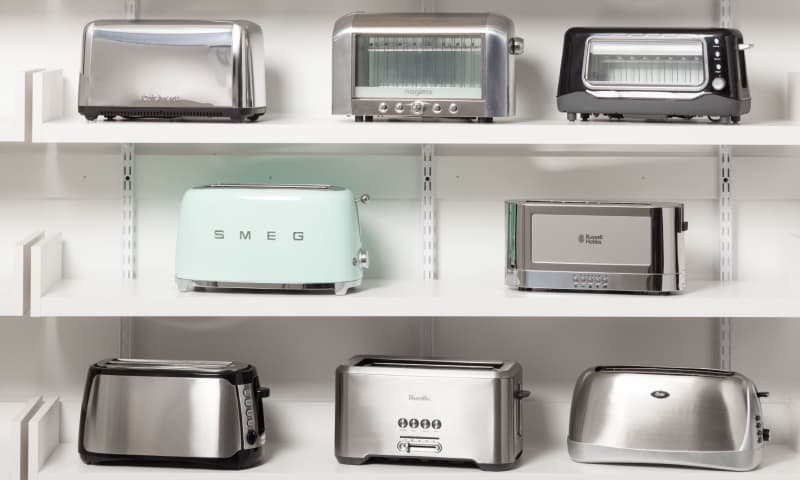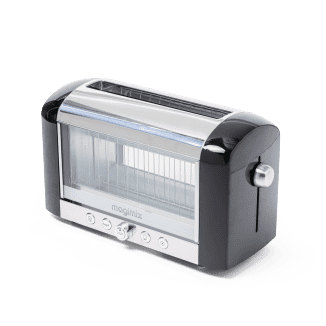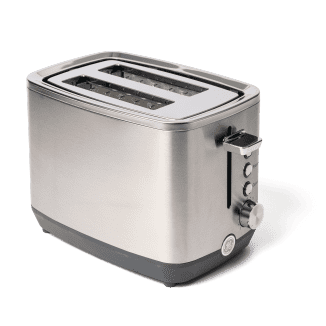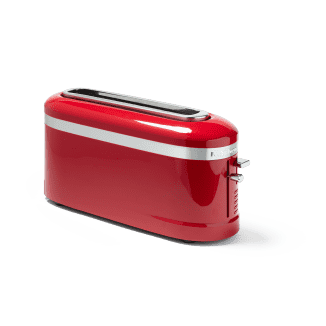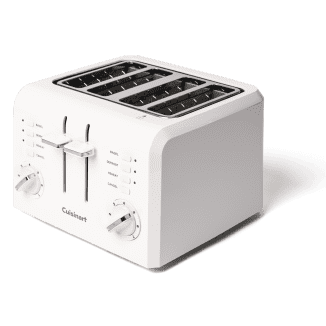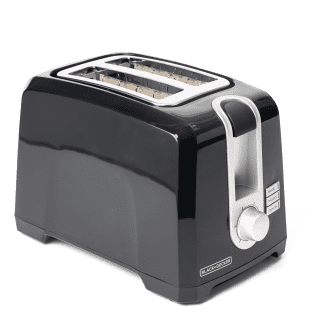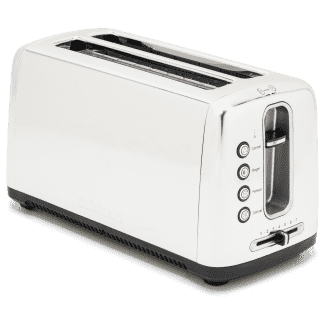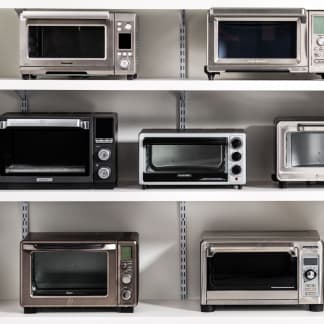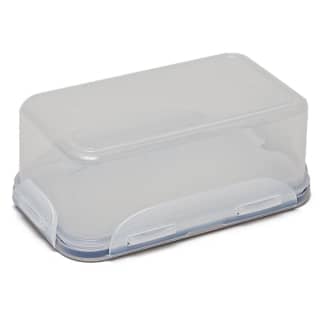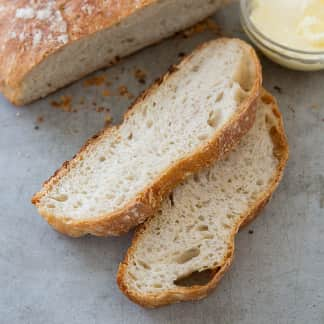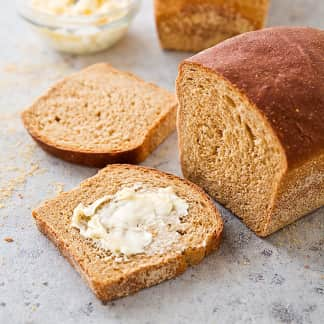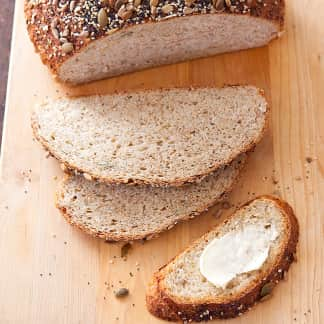Our favorite long-slot toaster, and our top choice overall, is the Magimix Vision Toaster. While pricey, this long-slot toaster toasts a wide variety of breads very evenly and has clear windows to monitor progress as your bread toasts. Our top conventional toaster is the GE 2-Slice Toaster. It toasts a more limited selection of breads fairly evenly, is easy to use, and has slots that are wide enough for bagels. It’s also a fifth of the price of our top choice, so it’s a great option not just for those who only toast sandwich bread and other shorter slices of bread but also for folks seeking a little more of a bargain.

Toasters have just one job: to make great toast. There are two basic types. Long-slot toasters, as the name suggests, have longer slots (some more than 10 inches long) meant to accommodate longer slices of artisanal bread or multiple slices of sandwich bread at a time. Regular toasters have shorter slots (under 6 inches long) and can only fit smaller pieces of bread. Both types have slots that are wide enough to fit thicker types of breads such as bagels or English muffins.
None of the toasters we tested were perfect all the time. Every type of bread, from a thin, sweet slice of white bread to a thick, crusty slice of sourdough, will toast at a different rate, and all machines will require some tinkering to find the ideal doneness for your preferences and the bread you’re using. Moreover, toasters are notoriously finicky and prone to failure; we’ve had to demote two successive winners after reports of uneven or erratic performance. We hope to do more research and testing in the future to find out more about why toasters are so finicky.
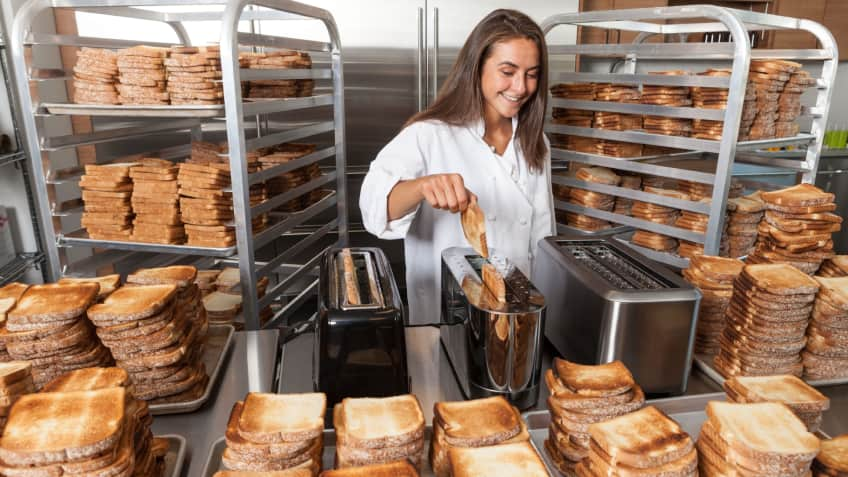
Which Type of Toaster Should You Get?
Overall, we prefer long-slot toasters because they’re more versatile, capable of toasting both small slices of supermarket sandwich bread and longer slices of artisan or sourdough loaves. Most long-slot toasters have just two slots but are big enough to allow you to toast two slices of sandwich bread per slot.

Conventional toasters are more compact and limited. They’re best for those with smaller kitchens and those who exclusively toast shorter items such as sandwich bread or English muffins. (You can also toast slices of larger artisanal or sourdough loaves as long as you cut them in half.) Conventional toasters often come in both two- and four-slot versions; the higher capacity is useful if you frequently need to make lots of toast at a time. We primarily tested two-slot conventional toasters for this review but plan to test more four-slot toasters in the future.
The price range for both types of toaster is roughly the same, so you won’t necessarily save money by getting one type or another, although our favorite conventional toaster is about a fifth of the price of our favorite long-slot option.
Should You Get a Toaster or a Toaster Oven?
If consistency and versatility are what you’re after, a toaster oven may be a better fit for you. A good toaster oven can produce much more evenly browned toast than toasters do. The downside is that they take far longer—up to 5 minutes—so while the toast may be more attractive, it can be a little dry. On the plus side, toaster ovens can perform more tasks: they can accommodate pretty much any type of bread: long, small, thick, or irregular slices. More importantly, they can also bake, broil, and roast a wide range of foods without making you turn on your larger oven. The tradeoff is size: these larger, more versatile machines can take up a lot of real estate on the counter. And of course, they often run a bit pricier than most one-use toasters.
Toasters only make toast, but they do so much more quickly, taking around 2 minutes for medium toast. (They’re faster because their heating elements are much closer to the bread.) This usually results in toast that is a bit more tender and less dried out than toast made in a toaster oven, but sometimes it’s less evenly browned. Toasters are typically less expensive and take up less counter space than toaster ovens.
Ultimately, the choice is personal and depends on space constraints and the tasks you prefer your appliances to do.
What to Look For
- Accurate, even toasting: Our favorite toasters produced toast that was evenly browned on both sides and in a range of doneness levels.

- Speed: The best toasters took 2 minutes or less to produce medium-brown toast that was crisp on the outside and tender on the inside.
- Deep slots: Toasters with slots that were at least 5 inches deep could accommodate tall slices of bread without leaving any of it to stick out of the top of the toaster.
- Simple, intuitive controls: We liked toasters that had straightforward buttons that were clearly marked and easy to use.
- Easy retrieval of toast: Our top toasters made it easy to remove toast from the toaster when ready. Some models automatically lifted the toast out of the slot upon completion, while others had a lever to lift the bread higher.
What Happens When You Make Toast
Some science is involved when soft bread turns into crispy toast: At 280 to 330 degrees, the surface of bread dries, its proteins and carbohydrates undergo the Maillard reaction, and sugars caramelize and brown. This changes its color, texture, aroma, and flavor and produces appetizing toast.
For long-slot toasters:
- Slots measuring at least 10 inches in length: Our favorite long-slot toasters had slots that were at least 10 inches long, allowing us to toast extra-long slices of artisanal bread or two slices of sandwich bread without being cramped.
Nice to Have
- Ability to monitor progress: Some toasters had clear windows that made it easy to monitor our toast as it browned. Another toaster had a “lift and look button,” which raised the toast so we could check on it without interrupting the cycle. These features help prevent that familiar toaster failure where you put toast back in for a little more color and end up burning it.
What to Avoid
- Uneven toasting: Many of the toasters we tested didn’t produce toast that was consistently browned from edge to edge. Some toasters gave us very patchy brown-and-white blotches across each side of a slice of bread, while others made toast that looked evenly golden on one side but completely different on the other side.
- Slow toasting: Some toasters took more than 2 minutes, or even close to 3 minutes, to make a medium-brown piece of toast, resulting in slightly drier toast than faster models.
- Shallow slots: Toasters with slots less than 5 inches deep sometimes left the tops of bread sticking out of the toaster.
- Tricky retrieval of toast: Some toasters made it difficult to remove toast from the machine because they didn’t lift toast automatically or lacked a lever for lifting. This meant we had to use a (nonmetal) utensil or risk burning our fingers to remove the toast.
Minor Flaws
- For long-slot toasters, slots shorter than 10 inches: Some long-slot toasters had slots that were shorter than 10 inches. While this was long enough to accommodate longer pieces of bread, we couldn’t toast two slices of sandwich bread per slot, limiting the models’ versatility.
Other Considerations
- Heating element—wires versus quartz: There are two types of heating elements used to toast bread. Most toasters work by heating rows of thin metal wires that line both sides of the toasting slot. We counted wires and found that the best toaster in this style had 15 wires on each side of its toasting slots; lower-rated models had as few as six or eight. But a few models use rods made of quartz instead of wires on each side of the toasting slots. Quartz heats and cools much more quickly than metal, and we liked the even, golden toast these models produced. But in the end, you can get good toast from machines with either type of heating element; it just depends on how they’re configured.
The Tests
- Measure overall dimensions and slot size
- Toast single slices of supermarket white sandwich bread on light, medium, and dark settings
- Time how long it takes to toast a slice of bread on medium setting; repeat test 5 times and calculate average speed
- Check exterior temperature while toasting to assess safety and comfort
- Toast slices of oversize artisan bread to examine fit, capacity, and performance
- Toast large, thick bagels with sesame seeds to examine fit and performance on bagel setting
- Toast 5 consecutive batches of sandwich bread, filling toaster to maximum capacity; note capacity and consistency of toast
- Ask testers to toast artisan bread to medium golden brown and rate ease of use
- Top 3 models: Toast 365 slices of bread in a row to test durability
- Empty crumb tray and clean exterior to evaluate ease of cleanup
How We Rated
- Speed: We rated the toasters on how quickly they produced toast.
- Cleanup: We evaluated the toasters on how easy they were to clean and keep tidy.
- Ease of Use: We rated the toasters on how easy they were to use (picking settings, retrieving toast, etc.)
- Performance: We evaluated the toasters on how evenly and accurately they toasted different breads at different settings.
